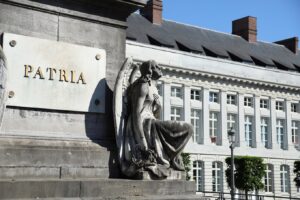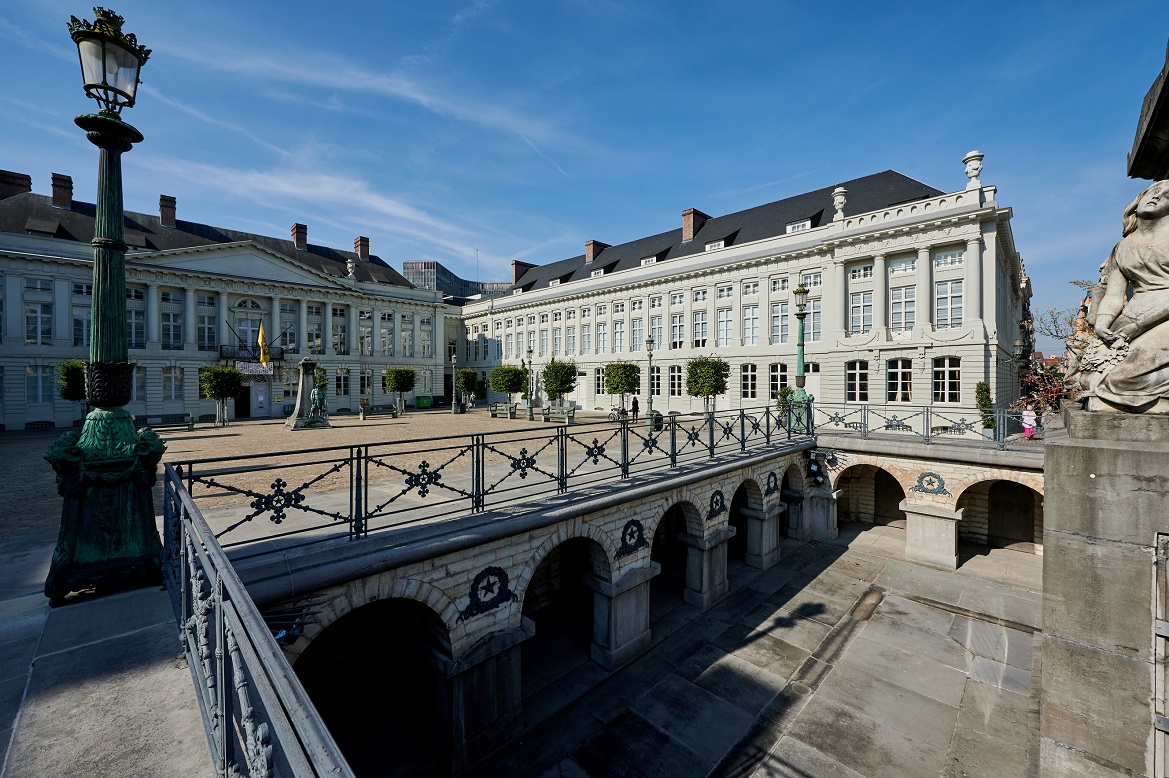The historic Place des Martyrs in the heart of Brussels was forgotten and abandoned for decades. As a new hotel opens its doors on the square, it is finally getting a facelift – and reminding people of its calming beauty.
The Place des Martyrs could have been a must-see sight of Brussels, a neoclassical square in the heart of the capital, a stately yet elegant refuge from the bustling city, where the heroes of the 1830 Belgian Revolution were laid to rest. Yet for decades, the square was ignored while its grandiose buildings fell into disrepair. Despite being just next to the City 2 shopping centre and Rue Neuve, it rarely sees foot traffic. Now, after years of decline and decay, the square is poised for a revival.
The restoration of the Place des Martyrs is thanks in large part to the arrival of Brussels’s latest five-star hotel. The Juliana Hotel Brussels is the crowning glory of a major refurbishment that promises to breathe new life into Place des Martyrs, bringing visitors, shoppers and tourists flocking back to this forgotten part of the city.
The hotel, which has taken over a corner that used to hold apartments and private residences, is in one of the original, listed buildings in the square. It has 43 rooms decorated by the Italian designer Eugenio Manzoni in a lavish baroque style that includes painted wallpaper, frescoes and expensive artwork. Eric Cléton, the owner of the Juliana Hotel Brussels, says that during the three years it has taken to rebuild the building, he has tried to respect the square’s role as a “central symbol of national heritage and identity.” The hotel, he believes, “honours this heritage with elegance.”
Craftsmen were brought in to ensure that the listed façade remained fully intact while the interior was gutted. When the work started, the place was a shell and visitors could see from the ceiling to the cellar. Now, everything inside is new. “Everyone involved, including the designers and architects, were mindful of the fact that this is a historically important building, and the square is important in Belgium’s history,” Cléton says.

Inside the Juliana hotel
Brussels mayor Phillip Close is among those welcoming the restoration. “This new hotel is a place of excellence and originality that is arriving in our city. Brussels, the capital of 500 million Europeans, can be proud to count this new and exclusive hotel in the city centre,” he says.
Jeroen Roppe, of Visit Brussels, the city’s tourist authority welcomes the square’s return to glory. “It’s something of a hidden gem in Brussels,” he says. “But the new hotel will, hopefully, help attract more visitors, both tourists and locals. The hotel and, more generally, the refurbishment of the square can play a key role in regenerating this part of the city centre. It’s an oasis in the centre of Brussels, and I think more people are going to now get to discover this.”
Belgium’s historical square
Place des Martyrs is replete with history, even if locals know relatively little about it. Just a stone’s throw from the La Monnaie theatre where the Belgian Revolution kicked off on August 25, 1830, it is the final resting place of the 445 freedom fighters who died in battles against the Dutch occupiers. Their remains are in an underground crypt beneath the cobblestones, and a monument at the square’s centre is dedicated to their memory.
But it first entered history at the end of the 16th century when, according to local historian Xavier Eugene, it was “a glorious meadow where the linen was dried for a fee.”
The square was commissioned in the 1770s by Charles of Lorraine, the Habsburg governor of the country, which was then known as the Austrian Netherlands. Constructed in 1774-6, it was designed by architectural engineer Claude Fisco as a symmetrical, closed square like the city’s Place Royale, built at the same time.
It’s also had various names over the years, first known as Place Verte in 1775 and then, three years later, becoming Place Saint-Michel. In 1795, under French rule, it took on yet another name, Place de la Blanchisserie, a nod to its days when it was used for bleaching textiles.

Guillaume Geefs's Pro Patria monument
The city archives say that after the 1830 Revolution, an order was given “that a grave would be dug on the Place Saint-Michel to receive the remains of citizens who died and that a monument would transmit the names to posterity of these heroes and the recognition of the Fatherland.”
Sculpted by Guillaume Geefs in 1836, the Pro Patria monument was erected in the form of a sculpture evoking Liberty, with the Lion of Belgium at its feet and angels at the pedastel’s corners. There is also a plinth dedicated to Frédéric de Mérode, who became a national hero after dying in the battle, and a monument to Louis Alexandre Dechet, the author of the lyrics of the Brabançonne, the Belgian national anthem.
Since then, it has been the site of numerous political demonstrations. On September 23, 1884, 3,000 people disrupted a national commemoration by singing La Marseillaise (the leaders Jean Volders and Louis Bertrand were later arrested). During the First World War, traditional celebrations were banned, but locals spontaneously gathered in the square to openly protest the German occupation.
Fall and rise
But over the years it fell into decline, with squatters occupying some of the buildings. Like the Grand Place, it was even used as a car park. It is now home to the cabinet offices of the Flemish government, including those of Jan Jambon, the Minister-President of Flanders. Since 1998, it has housed a theatre, the Théâtre des Martyrs. It’s also home to two bookstores and a clutch of upmarket apartments whose property values are among the highest in the city.
As for those who live there, the restoration of Place des Martyrs is more than welcome. “It’s wonderful that this is happening now,” says Antoine Van Cutsem, a retired accountant who has lived in an apartment on the square with his wife for over 20 years. “We remember what it was like not so long ago. People were squatting in some of the buildings which themselves were very rundown and sad looking. The square itself was overgrown and there was graffiti everywhere. The fact that it’s now got prestigious venues like the theatre and a luxury hotel reflects well on the efforts to bring it back to life.”

